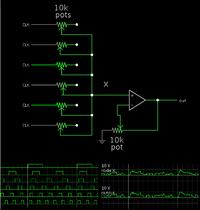paulked
Newbie level 3

- Joined
- Dec 21, 2011
- Messages
- 4
- Helped
- 0
- Reputation
- 0
- Reaction score
- 0
- Trophy points
- 1,281
- Activity points
- 1,313
Hi there.
I would like to solve a problem electronically rather than using relays (as I am doing at present).
I have to control the speed of a pump (via 0-10V signal) depending on the demand from various sources. I have 6 sources and some require more pump output than others. If more than one source is demanding then those demands are added. The circuit I'm using at the moment is this:

X1-1 - X1-6 Demand inputs
X1-8 = 10V
X1-9 = Output
X1-10 = 0V
This works ok for fixed demands but every time any of the demands change I have to change the value of the resistors.
Any ideas how I should approach this electronically?
Best regards
Paul Ked
I would like to solve a problem electronically rather than using relays (as I am doing at present).
I have to control the speed of a pump (via 0-10V signal) depending on the demand from various sources. I have 6 sources and some require more pump output than others. If more than one source is demanding then those demands are added. The circuit I'm using at the moment is this:

X1-1 - X1-6 Demand inputs
X1-8 = 10V
X1-9 = Output
X1-10 = 0V
This works ok for fixed demands but every time any of the demands change I have to change the value of the resistors.
Any ideas how I should approach this electronically?
Best regards
Paul Ked



